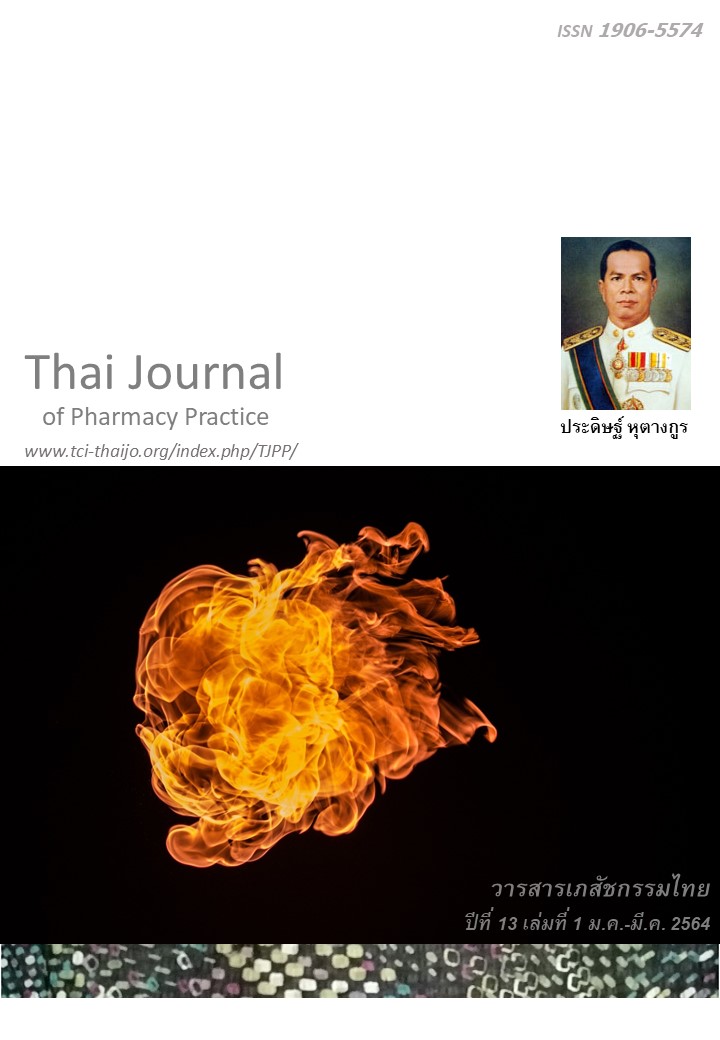การพัฒนาแบบวัดความร่วมมือในการใช้ยาสำหรับคนไทย
Main Article Content
บทคัดย่อ
วัตถุประสงค์: เพื่อพัฒนาแบบประเมินความร่วมมือในการใช้ยาสำหรับคนไทย (Medication Adherence Scale for Thais หรือ MAST) และหาจุดตัดคะแนนที่บ่งชี้ถึงระดับความร่วมมือในการใช้ยา (medication adherence: MA) วิธีการ: แบบวัดผ่านการทดสอบความตรงเชิงเนื้อหาโดยการตรวจสอบจากผู้เชี่ยวชาญ 3 ท่าน และการศึกษานำร่องในผู้ป่วยความดันโลหิตสูง 30 คน จากนั้นทดสอบขั้นต่อไปในผู้ป่วยโรคความดันโลหิตสูง ณ โรงพยาบาลปัตตานี 250 คน ผู้เข้าร่วมโครงการวิจัยทุกคนตอบแบบวัด MAST, SF-36, Marlowe–Crowne Social Desirability Scale (MCSD) ในเดือนที่ 0 และเดือนที่ 6 เมื่อสิ้นสุดการวิจัย ผู้วิจัยเก็บข้อมูลความดันโลหิตและนับเม็ดยาที่เหลือในเดือนที่ 0, 2, 4 และ 6 การหาเกณฑ์แปลผลคะแนนใช้การวิเคราะห์ receiver operator characteristics curve (ROC curve) ผลการวิจัย: สัมประสิทธิ์แอลฟาของครอนบาคของ MAST ในเดือนที่ 0 และเดือนที่ 6 เท่ากับ 0.87 และ 0.86 ตามลำดับ ความเที่ยงจากการทดสอบซ้ำอยู่ในเกณฑ์ดี (r=0.90) คะแนน MAST มีความสัมพันธ์กับ MA ที่วัดโดยการนับเม็ดยาที่เหลือ (r=0.56 ถึง 0.64; P<0.001) และ SF-36 (r=0.43-0.44, P<0.001) แต่ไม่มีความสัมพันธ์กับ MCSD (r=-0.086, P=0.175) เมื่อใช้ความสามารถในการควบคุมความดันโลหิตในเดือนที่ 6 เป็นตัวแปรมาตรฐานที่บ่งชี้ MA พื้นที่ใต้โค้ง ROC เท่ากับ 0.73 จุดตัดคะแนน คือ 34 คะแนน โดยมีค่าความไวร้อยละ 71.30 ความจำเพาะ ร้อยละ 69.10 ค่าการพยากรณ์บวกร้อยละ 61.02 และค่าการพยากรณ์ลบร้อยละ 78.03 สรุป: แบบวัด MAST มีความตรงและความเที่ยงที่ดี มีค่าความไว ความจำเพาะ และค่าพยากรณ์ที่ดี สามารถนำมาใช้ประเมิน MA ในผู้ป่วยความดันโลหิตสูง
Article Details
ผลการวิจัยและความคิดเห็นที่ปรากฏในบทความถือเป็นความคิดเห็นและอยู่ในความรับผิดชอบของผู้นิพนธ์ มิใช่ความเห็นหรือความรับผิดชอบของกองบรรณาธิการ หรือคณะเภสัชศาสตร์ มหาวิทยาลัยสงขลานครินทร์ ทั้งนี้ไม่รวมความผิดพลาดอันเกิดจากการพิมพ์ บทความที่ได้รับการเผยแพร่โดยวารสารเภสัชกรรมไทยถือเป็นสิทธิ์ของวารสารฯ
เอกสารอ้างอิง
Sabaté E. Adherence to long-term therapies: evidence for action. Geneva: World Health Organi zation; 2003.
Brown MT, Bussell JK. Medication adherence: WHO cares?. Mayo Clinic Proc 2011; 86: 304-14.
Johnson MJ, Williams M, Marshall ES. Adherent and nonadherent medication-taking in elderly hypertensive patients. Clin Nurs Res. 1999; 8:318 -35.
Tan X, Patel I, Chang J. Review of the four item Morisky Medication Adherence Scale (MMAS-4) and eight item Morisky Medication Adherence Scale (MMAS-8). Inov Pharm 2014; 5: 1-8.
Nasseh K, Frazee SG, Visaria J, Vlahiotis A, Tian Y. Cost of medication nonadherence associated with diabetes, hypertension, and dyslipidemia. Am J Pharm Benefits. 2012; 4: 41-7.
Arunsangsod K, Maneesriwongkul W, Panpakdee O. Effects of brief motivational interviewing on knowledge, motivation and medication adherence among patients with hypertension. Journal of Public Health Nursing 2014; 28: 130-1.
Vermeire E, Hearnshaw H, Van Royen P, Denekens J. Patient adherence to treatment: three decades of research. A comprehensive review. J Clin Pharm Ther 2001; 26: 331-42.
Farmer KC. Methods for measuring and monitoring medication regimen adherence in clinical trials and clinical practice. Clin Ther 1999; 21: 1074-90.
Svarstad BL, Chewning BA, Sleath BL, Claesson C. The Brief Medication Questionnaire: a tool for screening patient adherence and barriers to adherence. Patient Educ Couns 1999; 37:113-24.
Risser J, Jacobson TA, Kripalani S.Development and psychometric evaluation of the Self-efficacy for Appropriate Medication Use Scale (SEAMS) in low-literacy patients with chronic disease. J Nurs Meas. 2007; 15: 203-19.
Kim MT, Hill MN, Bone LR, Levine DM. Development and testing of the Hill-Bone Compli- ance to High Blood Pressure Therapy Scale. Prog Cardiovasc Nurs. 2000; 15: 90-6.
Thompson K, Kulkarni J, Sergejew AA. Reliability and validity of a new Medication Adherence Rating Scale (MARS) for the psychoses. Schi zophr Res 2000; 42: 241–7
Morisky DE, Green LW, Levine DM. Concurrent and predictive validity of a self-reported measure of medication adherence. Med Care 1986; 24: 67 –74.
Morisky DE, Ang A, Krousel-Wood M, Ward HJ. Predictive validity of a medication adherence measure in an outpatient setting. J Clin Hyper tens 2008; 10: 348-54.
Sakthong P, Chabunthom R, Charoenvisuthiwongs R. Psychometric properties of the Thai version of the 8-item Morisky Medication Adherence Scale in patients with type 2 diabetes. Ann Pharmaco ther 2009; 43: 950-7.
Phillips HP. Thai peasant personality: the patterning of interpersonal behavior in the village of Bang Chan. Berkeley: University of California Press; 1965.
Phansiniramon K. Cooperation in antiretroviral therapy in HIV and AIDS patients: the application of transient radioactivity model [master thesis]. Bangkok: Chulalongkorn University; 2006.
Akeasawerapong N. Factors affecting medication non-cooperation among schizophrenic patients at Suan Saranrom Hospital [master thesis]. Bangkok : Chulalongkorn University; 2006.
Cheychaiyaphum N. Factors predicting medication adherence among pulmonary tuberculosis patients [master thesis]. Bangkok: Chulalongkorn University; 2012.
Yonchoho T. Factor related to the adherence antiretroviral medication among HIV-infected persons in Bamrasnaradura infection disease institute [master thesis]. Bangkok: Ramkham- haeng University; 2005.
Boonprasan P. Effect of symbolic modeling on medication adherence among persons with major depressive disorders, Nongchang Hospital, Uthai Thani Province [master thesis]. Chiang Mai: Chiang Mai University; 2007.
Wachiradilok P. Effect of motivational interviewing and cognitive behavioral therapy for treatment adherence in schizophrenia [master thesis]. Khon Kaen: Khon Kaen University; 2006.
Bowen CW. Think-aloud method in chemistry education. J Chem Educ 1994; 71: 184-90.
Streiner DL, Norman GR, Cairney J. Health measurement scales: a practical guide to their development and use. Oxford: Oxford University Press; 2014.
Hinkin TR. A brief tutorial on the development of measures for use in survey questionnaires. Organ Res Methods 1998; 2: 104-12.
Crowne DP, Marlowe D. A new scale of social desirability independent of psychopathology. J Consult Psychol 1969; 24: 349-54.
Chaowalit A. Development and psychometric evaluation of the Ethical Issues Scale (EIS) for HIV/AIDs patient care in Thailand [dissertation]. Massachusetts: Boston College School of Nursing; 1997.
Sirimattayapant T, Intarakamhang P, Hemtasilpa S. Reliability of Thai version of SF-36 question naire for the evaluation of quality of life in stroke patients. Journal of Thai Rehabilitation Medicine 2006; 16: 10-6.
Karve S, Cleves MA, Helm M, Hudson TJ, West DS, Martin BC. Good and poor adherence: optimal cut-point for adherence measures using administrative claims data. Curr Med Res Opin 2009; 25: 2303-10.
Thai Hypertension Society. Guidelines in the treatment of hypertension [online]. 2012 [cited May 13, 2019]. Available from: www.thaihyperten sion.org/guideline.html
Raykov T, Marcoulides GA. Introduction to psycho metric theory. New York, NY: Routledge, Taylor & Francis Group; 2011.
Zhou XH, Obuchowski NA, Obushcowski DM. Statistical methods in diagnostic medicine. New York: Wiley & Sons; 2002.
Swets JA. Measuring the accuracy of diagnostic systems. Science 1988; 240: 1285-93.
Youden WJ. Index for rating diagnostic tests. Cancer 1950; 3: 32–5.
Kyngas HA, Skaar-Chandler CA, Duffy ME. The development of an instrument to measure the compliance of adolescents with a chronic disease . J Adv Nurs 2000;32:1499-506.
Suphachamroon A, Lerkiatbundit S, Saengcharoen W. Validity and reliability of medication adherence scale in Thais (MAST): testing in diabetes patients. Thai Journal of Pharmacy Practice 2018 ; 2: 607-19.
Sakthong P, Sonsa-Ardjit N, Sukarnjanaset P, Mun pan W, Suksanga P. Development and psychome tric testing of the medication taking behavior tool in Thai patients. Int J Clin Pharm 2016; 38: 438-45.


